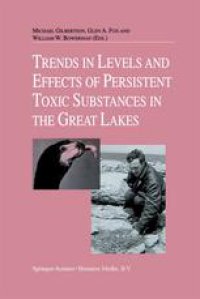
Ebook: Trends in Levels and Effects of Persistent Toxic Substances in the Great Lakes: Articles from the Workshop on Environmental Results, hosted in Windsor, Ontario, by the Great Lakes Science Advisory Board of the International Joint Commission, September 12
- Tags: Waste Water Technology / Water Pollution Control / Water Management / Aquatic Pollution, Ecotoxicology, Agriculture, Animal Physiology, Animal Anatomy / Morphology / Histology
- Year: 1998
- Publisher: Springer Netherlands
- Edition: 1
- Language: English
- pdf
`Are the Great Lakes getting better or worse?' This is the question that the public, scientists and managers are asking the International Joint Commission after a quarter-century of cooperative action by the United States and Canadian governments to clean up the Great Lakes. This volume contains papers from the workshop on Environmental Results, hosted in Windsor, Ontario, by the Great Lakes Science Advisory Board of the International Joint Commission, on September 12 and 13, 1996. The Great Lakes have been through almost a century of severe pollution from the manufacture, use and disposal of chemicals. In the 1960s wildlife biologists started to investigate the outbreaks of reproductive failure in fish-eating birds and ranch mink and to link these to exposure to organochlorine compounds. Human health researchers in the 1980s and 1990s linked growth retardation, behavioral anomalies and deficits in cognitive development with maternal consumption of Great Lakes fish prior to pregnancy. The Great Lakes became the laboratory where the theory of endocrine disruptors was first formulated. Now a group of Great Lakes scientists, hosted by the International Joint Commission, has compiled the story of the trends in the concentrations and effects of persistent toxic substances on wildlife and humans. The technical papers review the suitability of various organisms as indicators, and present the results of long-term monitoring of the concentrations and of the incidence of effects. The evidence shows that there was an enormous improvement in the late 1970s, but that in the late 1990s there are still concentrations of some persistent toxic substances that have stubbornly remained at levels that continue to cause toxicological effects.
Content:
Front Matter....Pages i-1
Trends in Concentrations and Effects of Persistent Toxic Contaminants in the Great Lakes: Their Significance for Inferring Cause-Effect Relationships and Validating Management Actions....Pages 3-15
Designing the Environmental Results Workshop: Historical Context, Causality and Candidate Species....Pages 17-55
Current Status and Temporal Trends in Concentrations of Persistent Toxic Substances in Sport Fish and Juvenile Forage Fish in the Canadian Waters of the Great Lakes....Pages 57-76
Organochlorine Contaminants in Herring Gull Eggs from the Great Lakes, 1974-1995: Change Point Regression Analysis and Short-Term Regression....Pages 77-115
Reproductive and Physiological Effects of Environmental Contaminants in Fish-Eating Birds of the Great Lakes: A Review of Historical Trends....Pages 117-145
Monitoring the Elimination of Persistent Toxic Substances from the Great Lakes; Chemical and Physiological Evidence from Adult Herring Gulls....Pages 147-168
Spatial and Temporal Trends in Organochlorine Contamination and Bill Deformities in Double-Crested Cormorants (Phalacrocorax Auritus) from the Canadian Great Lakes....Pages 169-195
Trends of Contaminants and Effects in Bald Eagles of the Great Lakes Basin....Pages 197-212
Long Term Trends in Liver Neoplasm Epizootics of Brown Bullhead in the Black River, Ohio....Pages 213-223
Reptiles and Amphibians: Shy and Sensitive Vertebrates of the Great Lakes Basin and St. Lawrence River....Pages 225-244
Human Health Effects of Environmental Pollutants: New Insights....Pages 245-258
Content:
Front Matter....Pages i-1
Trends in Concentrations and Effects of Persistent Toxic Contaminants in the Great Lakes: Their Significance for Inferring Cause-Effect Relationships and Validating Management Actions....Pages 3-15
Designing the Environmental Results Workshop: Historical Context, Causality and Candidate Species....Pages 17-55
Current Status and Temporal Trends in Concentrations of Persistent Toxic Substances in Sport Fish and Juvenile Forage Fish in the Canadian Waters of the Great Lakes....Pages 57-76
Organochlorine Contaminants in Herring Gull Eggs from the Great Lakes, 1974-1995: Change Point Regression Analysis and Short-Term Regression....Pages 77-115
Reproductive and Physiological Effects of Environmental Contaminants in Fish-Eating Birds of the Great Lakes: A Review of Historical Trends....Pages 117-145
Monitoring the Elimination of Persistent Toxic Substances from the Great Lakes; Chemical and Physiological Evidence from Adult Herring Gulls....Pages 147-168
Spatial and Temporal Trends in Organochlorine Contamination and Bill Deformities in Double-Crested Cormorants (Phalacrocorax Auritus) from the Canadian Great Lakes....Pages 169-195
Trends of Contaminants and Effects in Bald Eagles of the Great Lakes Basin....Pages 197-212
Long Term Trends in Liver Neoplasm Epizootics of Brown Bullhead in the Black River, Ohio....Pages 213-223
Reptiles and Amphibians: Shy and Sensitive Vertebrates of the Great Lakes Basin and St. Lawrence River....Pages 225-244
Human Health Effects of Environmental Pollutants: New Insights....Pages 245-258
....